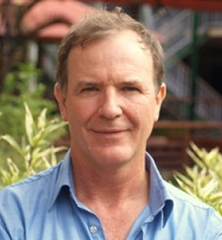You are here
Statement by Professor Stephen Garnett on World Migratory Bird Day 2018
 Professor Stephen Garnett
Professor Stephen Garnett
CMS COP-Appointed Scientific Councillorfor Birds, Charles Darwin University, Australia
Where I live in the Northern Territory of Australia migratory shorebirds arrive from Siberia each September to spend the non-breeding season feeding along the muddy shoreline. Six months later they are fat and ready to return. Roosting flocks are fidgety and fractious, waiting for the right winds. Suddenly they take flight, not low to the surface as they have all summer but rising higher and higher. They travel north, disappearing eventually above the silver Arafura Sea.
For us flightless humans standing on the shore such unfettered freedom to cross the world is both wondrous and moving. Those little flocks of shorebirds will fly unceasingly for thousands of kilometres to the shores of China and Korea. There they will fatten again on the rich alluvial silts gushing from East Asia’s great rivers before resuming their journey to their nesting grounds in the high Arctic. Some shorebirds may travel to and from the tropics 20 or 30 times over their lifetime. One was tracked on a single flight of over 11,000 kilometres across the Pacific.
World Migratory Bird Day is to remind us of our need for stewardship of these and others among the world’s migrants. While their travels may be wild and free, where they land and find nourishment is invariably under at least some human influence.
The names of shorebirds - turnstone and godwit, knot and plover, stint, curlew and sanderling – are ancient, reflecting aeons of connection between people and birds. For a long time their comings and goings must have been mysterious. I lived once on a remote island off New Guinea where shorebirds are known as the birds-whose-nests-are-never-found. But, the more we learn about these migrants – indeed all migratory birds - the more extraordinary and precious their behaviour becomes. And the more we realize how important people are to enabling this migration to occur.
The Convention on Migratory Species provides international acknowledgement of the fragility of migratory species’ environments and of the need to work together to protect them. Most species are like most people – citizens of a single country from which they draw sustenance all their lives. For sedentary species, single countries can provide all the laws and regulations needed to ensure survival for future generations.
Not so migrants. Migrants are global citizens recognizing no arbitrary human cartography. And it is as global citizens we must cooperate to keep them. Of course the threats we create for migratory birds have long crossed boundaries too – pollution, climate change, invasive species - but it is birds that energize much of the international collaboration for environmental protection along migration routes. They carry with them a higher value beyond mere money. While there may be material human benefit from saving migratory species, it is what they represent that is far more important.
For migratory birds not only link countries together but increasingly peoples. The East Asian – Australasian flyway along which the shorebirds travel is just one of three or four grand corridors between north and south. A few species even travel east-west. Coordinated conservation along these routes can only be achieved if people work together for a common good. And working together for one common good can help us all realize that there are many common goods for which we can strive.
For migratory birds touch something deeper than the cultural and political differences that can separate peoples. They fly past the barriers that divide countries and can carry us with them. This April a curlew from Darwin carrying a transmitter was refuelling for the next stage in its northward migration along the Korean coast. One day it was north of the demilitarized zone, the next day it was feeding not far from Seoul. Researchers from both North and South Korea are working with others along the flyway to ensure curlews can continue to flout the constraints of human history. Perhaps one day curlews will help bring down those barriers between people too.
So the world’s migratory birds which we celebrate today should be seen not just as extraordinary natural marvels but also as metaphors of a closer, connected world, tied together by the virtual threads that follow each migrating bird across the globe.
